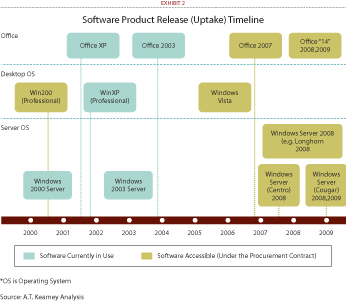For years, software vendors required customers to pre-pay for licensing fees and regular maintenance to cover patches, upgrades, and support. Today, these upfront payments have largely been replaced with a pay-for-usage model. And increasingly, some independent software vendors are offering “cloud” delivery whereby virtual resources—infrastructure, applications, and data—are deployed via the Internet.
Cloud services are scaleable and priced on a pay-per-use basis. They are best known as software-as-a-service or SaaS, platform-as-a-service or PaaS, and virtual infrastructure-as-a-service or IaaS. While cloud computing continues to enjoy market momentum and can result in significant savings, each cloud service has a different life-cycle position and contributes different levels of value. (See Exhibit 1.)
In addition, there are several barriers to adopting cloud computing, from loss of data security and power to control IT services, to lack of transparency into IT costs. Indeed, to this latter point, while SaaS delivery models might be effective for some functional markets, many executives do not consider SaaS for use in business-critical applications because key prerequisites—such as IT cost transparency and standardization of IT service offerings—have not yet been achieved. So, while pay-per-use licenses may enhance cloud offerings, they will not replace on-premise software anytime soon. As such, key decisions about software asset management must still be made internally.
Consider, for example, businesses that are not leading-edge adopters of Microsoft technology. They often fall into a demand-management trap in which they fail to perform proper due diligence on what is actually needed before entering into Microsoft enterprise software agreements. This leads to product proliferation, lack of standardization, and sub-optimal asset utilization, which almost always inhibit value creation.
For these reasons, companies have to maintain control over their software assets—making sure that demand and consumption patterns are properly aligned and balanced. We now turn to a case study to explain why this is true.
 Managing Software Demand
Managing Software Demand
Like most consumers of Microsoft software, this large European high-tech company was challenged to keep up with version upgrades of its software license agreement. Our work began with a portfolio cleanup, identifying loopholes in the purchasing process to ensure that all products purchased were aligned with usage. The procurement function was reorganized, and a demand-management strategy was used to prune software licenses.
Next, we focused on consolidating the reseller supply base and deflecting volume to a preferred reseller to improve negotiation leverage. As a result, the company reduced addressable spend by 16 percent and its reseller footprint by 96 percent.
A review of current inventory relative to projected usage revealed that the company was not a leading-edge adopter of Microsoft products. Because of its slow pace in adopting Microsoft’s options (which, again is typical among large organizations), the company decided to cancel its Microsoft agreement, buy out all required licenses, and use a “select” model to purchase required licenses ad hoc post-Vista and -Office 2007 upgrades. (See Exhibit 2.) Afterwards, the company can repurchase required licenses under a more appropriate procurement vehicle.
During the buy-out estimation process, the company maintained an agnostic negotiation stance with Microsoft, continuing to standardize open-source software and leveraging software substitutes where possible. Also, some server demand was diverted to a standard Linux software, which reduced dependence on Microsoft and, perhaps more important, sustained competitive tension for future negotiations.
Learning its lesson about relying on a vendor for software demand management, the company designed its future model to include centralized license management. This will prevent excess inventory and improve asset utilization across all business units.
Looking Under the Hood
While developing a comprehensive software demand-management strategy is challenging, it is an indispensable tool even in today’s world of cloud computing. Companies can reap significant financial rewards by “looking under the hood,” understanding their existing use of assets and aligning their software demand and consumption patterns.
As our case-study client discovered, the best companies keep their eye on software asset management and align procurement vehicles to internal demand and consumption patterns, as the use of cloud computing in business-critical applications is still limited.
SC
MR

More Software
- Technology’s role in mending supply chain fragility after recent disruptions
- Tech investments bring revenue increases, survey finds
- Game on: Rethinking change management for the digital era
- Predicting stockouts: Enhancing FMCG resilience through data-driven insights
- Electronics Supply Chain Seeks Balance in 2024
- Digital Approaches, End-to-End Thinking Help Supply Chains Evolve
- More Software
Latest Podcast

 Explore
Explore
Software & Technology News
- Technology’s role in mending supply chain fragility after recent disruptions
- Tech investments bring revenue increases, survey finds
- Survey reveals strategies for addressing supply chain, logistics labor shortages
- AI, virtual reality is bringing experiential learning into the modern age
- Humanoid robots’ place in an intralogistics smart robot strategy
- Tips for CIOs to overcome technology talent acquisition troubles
- More Software & Technology
Latest Software & Technology Resources

Subscribe

Supply Chain Management Review delivers the best industry content.

Editors’ Picks




